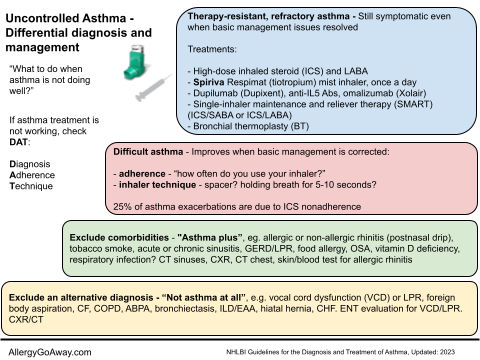Severe asthma in children is characterized by sustained symptoms despite treatment with high doses of inhaled corticosteroids or oral corticosteroids. Severe asthma is divided into 2 categories:
- difficult-to-treat asthma - poor control due to an incorrect diagnosis or comorbidities, or poor adherence
- severe therapy-resistant asthma - poor control despite management of the factors above

Severe asthma: “What to do when asthma is not doing well?” (click to enlarge the image).
Severe asthma is a highly heterogeneous disorder associated with a number of clinical and inflammatory phenotypes.
Guideline-based drug therapy of severe childhood asthma is based primarily on extrapolated data from adult studies. Children with severe asthma should be treated with higher-dose inhaled or oral corticosteroids combined with long-acting β-agonists and other add-on therapies, such as antileukotrienes and methylxanthines.
It is important to identify and address the influences that make asthma difficult to control, including reviewing the diagnosis and removing causal or aggravating factors.
Better definition of the phenotypes and better targeting of therapy based upon individual patient phenotypes is likely to improve asthma treatment in the future.
References:
Severe Asthma in Children. Theresa W. Guilbert, et al. The Journal of Allergy and Clinical Immunology: In Practice, Volume 2, Issue 5, Pages 489–500, September–October, 2014
(free full text)
http://www.jaci-inpractice.org/article/S2213-2198(14)00300-6/fulltext
- difficult-to-treat asthma - poor control due to an incorrect diagnosis or comorbidities, or poor adherence
- severe therapy-resistant asthma - poor control despite management of the factors above
Severe asthma: “What to do when asthma is not doing well?” (click to enlarge the image).
Severe asthma is a highly heterogeneous disorder associated with a number of clinical and inflammatory phenotypes.
Guideline-based drug therapy of severe childhood asthma is based primarily on extrapolated data from adult studies. Children with severe asthma should be treated with higher-dose inhaled or oral corticosteroids combined with long-acting β-agonists and other add-on therapies, such as antileukotrienes and methylxanthines.
It is important to identify and address the influences that make asthma difficult to control, including reviewing the diagnosis and removing causal or aggravating factors.
Better definition of the phenotypes and better targeting of therapy based upon individual patient phenotypes is likely to improve asthma treatment in the future.
References:
Severe Asthma in Children. Theresa W. Guilbert, et al. The Journal of Allergy and Clinical Immunology: In Practice, Volume 2, Issue 5, Pages 489–500, September–October, 2014
(free full text)
http://www.jaci-inpractice.org/article/S2213-2198(14)00300-6/fulltext